Modelling Natural Radioactivity in Sand Beaches of Guarapari, Espírito Santo State, Brazil ()
1. Introduction
People are exposed to ionizing radiation from naturally occurring radionuclides that there are in the earth’s environmental. Radionuclides in soils, belonging to 232Th, 235U and 238U series as well as radioisotope of potassium (40K) are the major contributors of outdoor terrestrial natural radiation [1]. These radionuclides are not uniformly distributed, their concentration depends upon the local geology of each region in the world [2]. Although their presence result in a relatively small amount of radiation dose, in some regions known for high background radiation levels (HBRA) [3], the knowledge of their distribution in soil, sand and rock plays an important role in radiation protection and measurement [2]. Ramsar, Iran [4], due to the concentration of 226Ra and daughters which are brought to Earth’s surface by hot springs, and Orissa and Kerala, India [5], due to the monazite sands, are examples of HBRA. In certain beaches of Brazil, there are areas known for their high background radiation, which geological and geochemical characteristics increase the levels of natural radiation [3]. Monazite sand is the main source of the high background from Atlantic coast from Brazil and it contributes to increase the environmental dose. The more important area begins below Guarapari, Espírito Santo, going up Porto Seguro, Bahia (Figure 1), and it is formed by pre-Cambrian rocks and Tertiary and Quarternary deposits. In 2009, the Departamento de Engenharia Nuclear (DEN)/Universidade Federal de Minas Gerais (UFMG) and Centro de Desenvolvimento da Tecnologia Nuclear (CDTN)/Comissão Nacional de Energia Nuclear (CNEN) began a research to determine reference levels of this region using gamma spectrometry. The first part of this research analysed beach sands from the extreme south of Bahia state, between Porto Seguro and Caravelas (Figure 1) [6]. The results showed Cumuruxatiba as HBRA region. Continuing in the south direction, Guarapari is a region cited by some studies [2,7,8] by its high environmental radiation. In this work, the same methodology as used in Cumuruxatiba was applied to evaluate the Guarapari area. The gamma-ray activity of radioisotopes such as 232Th, 226Ra, and 40K, in beach sand samples from Guarapari was measured and the absorbed dose rate and the effective dose rates were calculated and compared with internationally accepted values as well as others HBRAs. The goal is validate the measurement methodology comparing the results obtained in this work with data referenced

Figure 1. Geographic localization of the extreme south of Bahia state and of the Guarapari city from Espírito Santo State (modified from [11,12]).
in some studies.
2. Material and Methods
Beach sand samples were collected in Areia Preta, Praia do Morro and Setiba in Guarapari city, Espírito Santo state, in January 2010. The samples were collected from about 10 cm deep. Each sample was collected from an area corresponding to 1 m2 and were homogenized in situ. This sand mixture, weighing approximately 1.5 kg, was considered representative of the profile, as done by [9]. For each local, twelve samples have been measured. The samples were dried for about 48 hours in an oven at 60˚C. The analytical technique used for the gamma emitters isotopes 214Bi (226Ra), 228Ac (232Th) and 40K was gammaray spectrometry. Table 1 shows the radionuclides, the specific gamma-ray line used and the detection limits that were calculated according to procedures and experimental conditions [10].
2.1. Gamma-Ray Spectrometry
The specific activities of the radionuclides 226Ra and 40K in the collected samples are determined in a specially reduced background detection system, consisting of a hyper-pure germanium detector (HPGe), coaxial geometry, 15% relative efficiency. The data are treated with Genie 2000 software. The efficiency and energy curves for calibrations are determined using internationally certificate standard solution prepared by PNI/IRD/CDTN (Programa Nacional de Intercomparação/Instituto de Radioproteção e Dosimetria/Centro de Desenvolvimento da Tecnologia Nuclear). The samples, after being dried and weighed, are transferred to Marinelli beakers (500 mL). Each sample is hermetically and carefully sealed to prevent the escape of gaseous 222Rn and 220Rn. It is kept aside for 30 days to reach radioactive equilibrium of the 226Ra between 214Pb and 214Bi radon’s daughters. In 232Th decay chain the radioactive equilibrium of 232Th between 228Ra and 212Pb is easily reached due the short half-life of
Table 1. Gamma-ray lines and detection limits for the radionuclides.
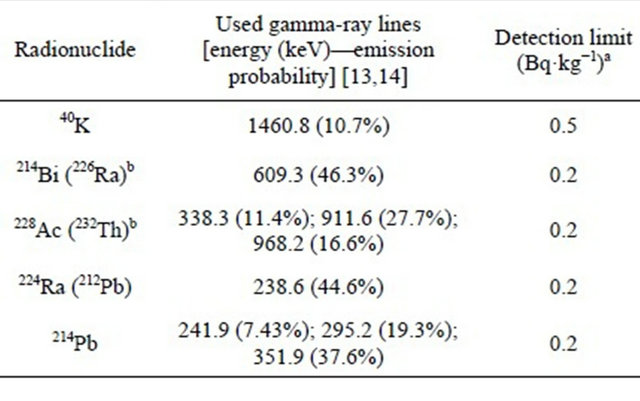
aThe detection limit is given by the equation LD = 2.71 + 4.65δ for 95% confidence limit, where δ is the standard deviation of the background in the peak interval; bThe gamma-ray lines represent 226Ra, 212Pb and 232Th were determined indirectly by 214Bi, 224Ra and 228Ac respectively.
the decay products of 228Th. In environment, 226Ra is in equilibrium with 238U and 228Ra is in equilibrium with 232Th only if no occur leaching 226Ra, 228Ra and its parents. After, all samples are submitted to gamma-ray spectrometry. The samples are counted for 24 hours in order to obtain statistically small uncertainty for the gamma-ray peak of interest.
Following the spectrum analysis, count rates for each detected photo peak and activity concentration in units of Becquerel per kilogram for each nuclide are calculated based on the Equation (1):
 (1)
(1)
where NEi is the net peak area at energy Ei of radionuclide i; t the counting time in seconds; m is the mass of samples in kg; ɛEi and γEi are detection efficiency and emission probability of gamma-ray, respectively.
2.2. Calibration
Energy calibration was performed in the energy range using point sources from 0.1 to 2 MeV made by Institute of Isotopes Co., Ltd., Budapest, Hungary. The following photon emissions and radionuclides were used: 241Am, 133Ba, 152Eu, 109Cd and 60Co. The efficiency calibration curve, showed in Figure 2, was determined using a standard solution made by the National Institute of Standards and Technology (NIST) and reference materials with densities and compositions similar to the samples that will be measured after pulverization. Marinelli beakers of 500 mL were also used for the reference materials. Each sand sample, of approximately 1.0 kg, was counted for 86,400 s. All samples were measured in a low background spectrometry system inside a special counting room, shielded by water all around, over and below. The background spectrum collected from the standard solution for 24 hours is show in Figure 3.
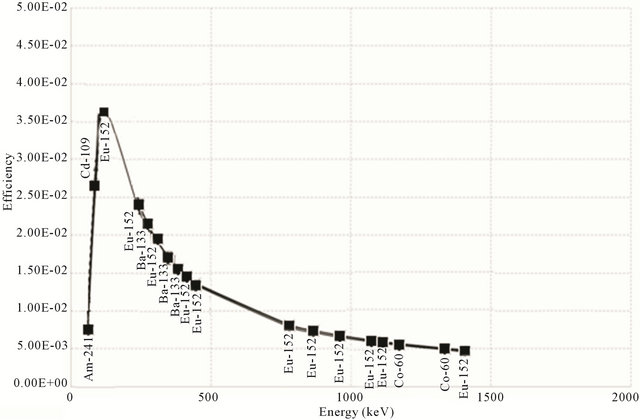
Figure 2. Absolute efficiency curve of detector HPGe from CDTN/CNEN used for analyses.
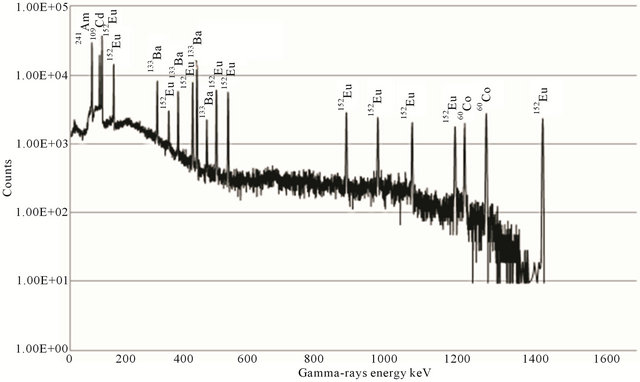
Figure 3. Background spectrum collected from the standard solution.
2.3. Dose Calculation
The total air absorbed dose rate (nGy·h−1) 1 m above the ground due to the specific activities of 226Ra, 232Th and 40K (Bq·kg−1) was calculated using the Equation (2) [2,3]
 (2)
(2)
where D is the absorbed dose rate, AK, ARa and ATh are the activity concentrations for 40K, 226Ra and 232Th respectively.
To estimate the annual effective dose rates, the conversion coefficient from absorbed dose in air to effective dose (0.7 Sv·Gy−1) and outdoor occupancy factor (0.2) proposed by [10] were used. The effective dose rate in units of mSv·y−1 was calculated by following Equation (3):
 . (3)
. (3)
where D is the calculated dose rate (in nGy·h−1), T is the outdoor occupancy time (24 h × 365.25 days × 0.2 = 1753 h·y−1), and F is the conversion factor (0.7 Sv·Gy−1).
3. Results and Discussions
The activity concentrations of radionuclides measured in beach sand samples from Guarapari, Brazil are presented in Table 2. The naturally occurring 226Ra, 214Pb, 232Th, 212Pb and 40K in beach sands ranged from 6.0 to 4100, 6.0 to 3600, 20 to 57,000, 17 to 47,500 and 73 to 3000 Bq·kg−1 respectively. All radionuclides found in these beaches sand samples are radioisotopes from the uranium, thorium and actinium decay series plus the 40K. The radioisotopes 226Ra, 214Pb and 212Pb are the daughter products of the 232Th and 238U decay series.
As shows in Table 2, determination of the activity of some 238U and 232Th decay products shows that radionuclides are in secular equilibrium. For example, the value for 214Pb activity (end of the 238U decay chain) is equal to the 226Ra activity (beginning in the decay chain). Thus, these data do not show any evidence of disequilibrium between radionuclide activities. The values of 226Ra, 232Th and 40K in Areia Preta are higher than the range of the corresponding typical world values. However, the values of radionuclides in Praia do Morro and Setiba are lower than the range of the corresponding typical world values. The determination of 232Th/238U and 238U/214Pb ratios is pertinent in understanding the status of secular equilibrium. If 226Ra, or daughters, are in secular equilibrium with 238U, their activity ratios and of their daughters, would be equal to unity [3]. According to [15], the analysis of the naturally occurring radioactive materials (NORM) relative abundance (Th/U, K/U and K/Th ratios) may give information on the enrichment/depletion processes as a result of the complex metamorphic history, alteration and/or weathering, which affected the investigated rocks. The 232Th/238U ratio calculated in Areia Preta was of 13.9. This value shows that there is much more 232Th in samples compared to 238U and it is much higher than the continental crustal average concentration of 3.82 reported by [16]. The 40K/238U and 40K/232Th ratios are 0.73 and 0.05 respectively, but it must be highlighted that these values are highly variables. The 226Ra/ 214Pb ratio calculated was of 1.1. This ratio shows a radioactive equilibrium. Figure 4 shows an acceptably correlation between activity concentration of 238U (226Ra) and 232Th in the beach sand samples from Areia Preta, with a linear coefficient of 0.821.
Table 3 shows the results of the total absorbed dose rate in the air due to gamma-ray radiation (D) and the outdoor annual effective dose rate (HE) assessment for beach sand samples.
As can be observed in Table 3, only the values of the absorbed dose rates in Areia Preta are higher than the estimate of average global primordial radiation of 59 nGy·h−1 and the world range (10 - 200 nGy·h−1) [3]. The results show that the absorbed dose rates range from 18 - 37,500 nGy·h−1. The largest contribution from natural radionuclides in Areia Preta to the absorbed dose rate in air is due to 232Th, about 94.7% and 226Ra contributes about 5%. The contribution of 40K is negligible. Adopting the conversion factor that converts the absorbed dose rate in air to human effective dose equivalent, an outdoor occupancy factor which is the fraction of time spent outdoors as recommended by [3], and the mean value of absorbed dose rate obtained in the present study, the average annual outdoor effective dose is computed to be 43.00 in Areia Preta. This value is much greater than the world average value assessed by [3]. Presence of mineral monazite is the cause of the high dose. Monazite is a monoclinic mineral consisting of 70% of rare earths phosphates; thorium oxide 4% - 6% and uranium oxide 0.15% - 0.25% [7]. The ilmenite and monazite rich sands of Guarapari have attracted tourists because of their supposed therapeutic properties.
Table 4 shows the activity concentrations of the 226Ra, 232Th and 40K measure in some works in Areia Preta beach from Guarapari, Brazil. The region already is well studied, therefore is an ideal local for comparison of the measures. Our measurements of 226Ra and 232Th from Areia Preta agree with the values measured by [2], al-
Table 2. Concentration of radionuclides in beach sand samples.

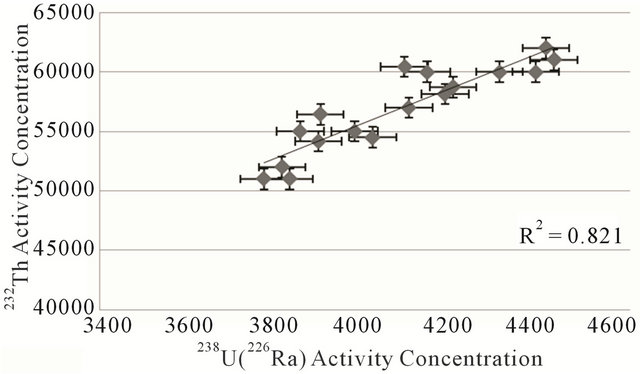
Figure 4. Correlation between activity concentrations of 238U (226Ra) and 232Th in beach sand samples from Areia Preta.
Table 3. Average total absorbed dose rate in air from natural radionuclides 226Ra, 232Th and 40K and annual effective dose in beach sands of Guarapari.
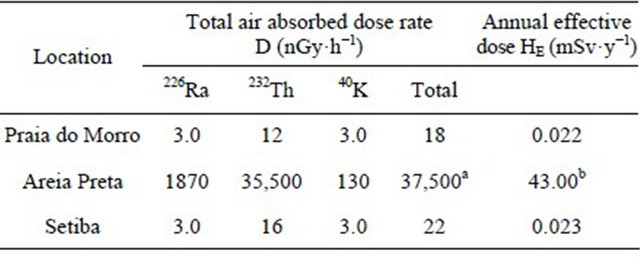
aValues higher than the world range (10 - 200 nGy·h−1); bValues higher than worldwide average (0.07 mSv·y−1).
though the value of 40K is disagreement. This is expected because there are variations in environment potassium due to the variation of the organic matter. Works of more 10 years ago have lower values for 226Ra and 232Th than the recent works.
In Table 5, a summary of results on natural gammaray radioactivity levels derived from similar investigation conducted in some of world regions and around the Atlantic coast of Brazil is presented. Activity concentrations of 226Ra (238U daughter) from Cumuruxatiba, Bahia state, is higher than the others locals showed in the summary. According to [6], Cumuruxatiba is a place which has a large amount of monazite sand (4500 t) and indicates that the monazite deposit in Cumuruxatiba is more extensive than Guarapari. However, the highest activity concentration of 232Th was found in Guarapari. On the
Table 4. Comparison of the activity concentrations of the main radionuclides gamma-ray emitter measure in some works in Areia Preta beach, Guarapari, Brazil.
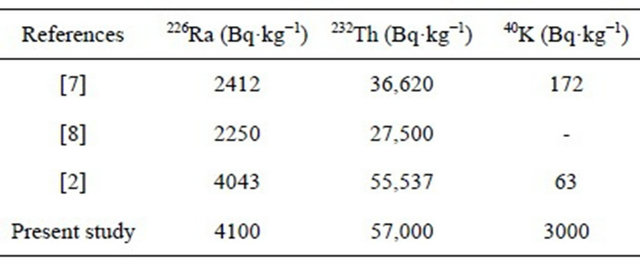
Table 5. Summary of activity concentrations and dose rates of natural radioisotopes in soil and sand samples in some of the world regions; (-) not determined.
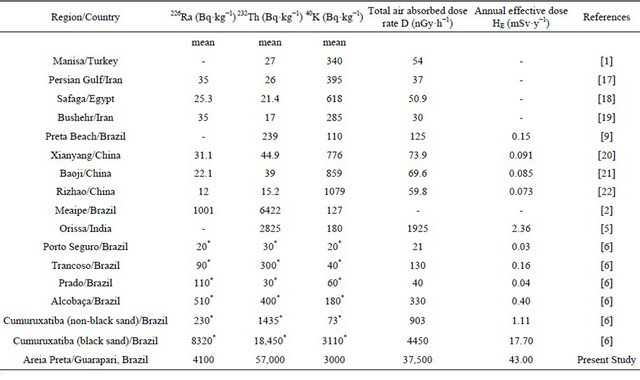
*Maximum value.
other hand, 238U concentration is highest in Cumuruxatiba. The activity concentration of 40K from Cumuruxatiba is higher than the others regions and slightly higher than Guarapari. Values of total air absorbed dose rate (D) and annual effective dose (HE) from Guarapari are very higher than the values from Orissa, India [5] and Cumuruxatiba, Brazil [6]. Orissa and Cumuruxatiba are HBRAs.
4. Conclusion
The exposure level due to monazite sand radiation in Areia Preta beach, Guarapari, is high. The activity concentration of 232Th in Areia Preta is higher than others beaches in world studied and others regions from coast Brazilian such as Cumuruxatiba and Porto Seguro although the activity concentration of 238U is lower than Cumuruxatiba. The values of the absorbed dose rate in air and outdoor annual effective dose rate in Areia Preta beach are higher than the world averages due the content of 232Th. Areia Preta has the highest background found in beaches in world and beside Cumuruxatiba are highest background from coast Brazilian with values much higher than worldwide average. The measured values in Areia Preta agree with values found by others studies which validate our methodology.
5. Acknowledgements
The authors thank to the Centro de Desenvolvimento da Tecnologia Nuclear—CDTN/CNEN, where this study was carried out. The authors also are grateful to FAPEMIG, CNPq and CAPES for financial assistance.